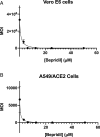Bepridil is potent against SARS-CoV-2 in vitro
- PMID: 33597253
- PMCID: PMC7958448
- DOI: 10.1073/pnas.2012201118
Bepridil is potent against SARS-CoV-2 in vitro
Abstract
Guided by a computational docking analysis, about 30 Food and Drug Administration/European Medicines Agency (FDA/EMA)-approved small-molecule medicines were characterized on their inhibition of the severe acute respiratory syndrome coronavirus 2 (SARS-CoV-2) main protease (Mpro). Of these small molecules tested, six displayed a concentration that inhibits response by 50% (IC50) value below 100 μM in inhibiting Mpro, and, importantly, three, that is, pimozide, ebastine, and bepridil, are basic molecules that potentiate dual functions by both raising endosomal pH to interfere with SARS-CoV-2 entry into the human cell host and inhibiting Mpro in infected cells. A live virus-based modified microneutralization assay revealed that bepridil possesses significant anti-SARS-CoV-2 activity in both Vero E6 and A459/ACE2 cells in a dose-dependent manner with low micromolar effective concentration, 50% (EC50) values. Therefore, the current study urges serious considerations of using bepridil in COVID-19 clinical tests.
Keywords: COVID-19; SARS-CoV-2; bepridil; drug repurposing; main protease.
Copyright © 2021 the Author(s). Published by PNAS.
Conflict of interest statement
The authors declare no competing interest.
Figures





Update of
-
Bepridil is potent against SARS-CoV-2 In Vitro.bioRxiv [Preprint]. 2020 Jul 27:2020.05.23.112235. doi: 10.1101/2020.05.23.112235. bioRxiv. 2020. Update in: Proc Natl Acad Sci U S A. 2021 Mar 9;118(10):e2012201118. doi: 10.1073/pnas.2012201118. PMID: 32511370 Free PMC article. Updated. Preprint.
References
-
- Gates B., Responding to Covid-19—A once-in-a-century pandemic? N. Engl. J. Med. 382, 1677–1679 (2020). - PubMed
-
- Morens D. M., Daszak P., Taubenberger J. K., Escaping Pandora’s box—Another novel coronavirus. N. Engl. J. Med. 382, 1293–1295 (2020). - PubMed
-
- World Health Organization , WHO Coronavirus disease (COVID-19) dashboard. https://covid19.who.int/. Accessed 4 February 2021.
Publication types
MeSH terms
Substances
LinkOut - more resources
Full Text Sources
Other Literature Sources
Research Materials
Miscellaneous

